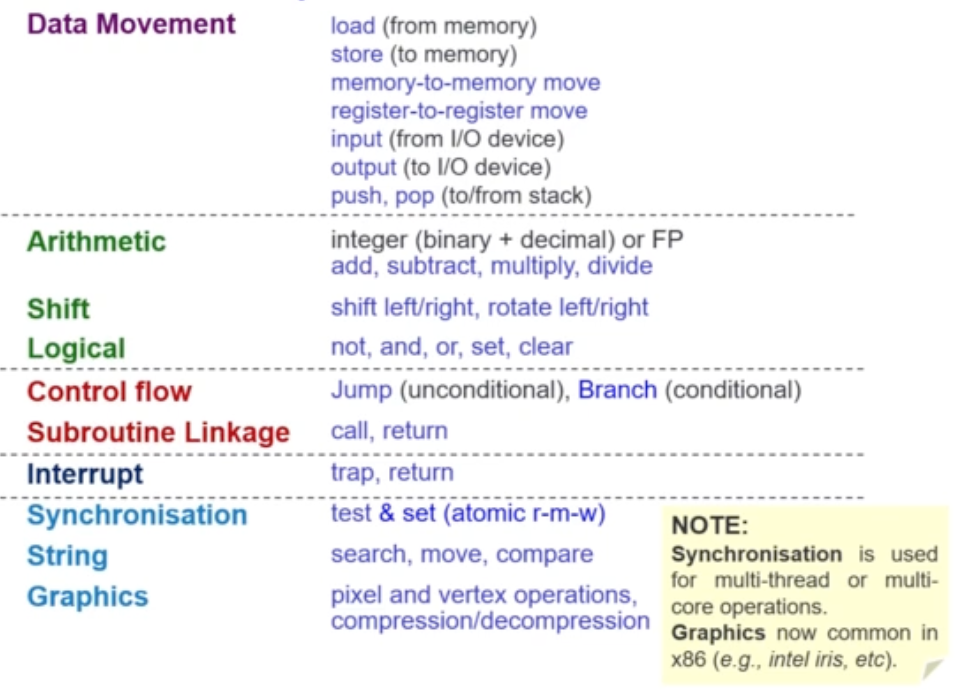RISC vs CISC: The Famous Battle
There are two major design philosophies for ISA
Complex Instruction Set Computer (CISC)
e.g. x86-21 (IA32)
- Single instruction to perform complex operations
- VAX Architecture had an instruction to multiply polynomials
- Smaller program size as memory was premium
- Complex implementation, no room for hardware optimization Memory
- Mixture of Register-Register and Register-Memory
Reduced Instruction Set Computer (RISC)
e.g. MIPS, ARM
- Keep the instruction set small and simple, makes it easier to build/ optimise hardware
- Burden on software to combine simpler operations to implement high-level language statements Memory
- Typically use Register-Register
The 5 Concepts in ISA Design
Data Storage
Concerned with
- Where do we store operands so that we can perform computation?
- Where do we store computation results?
- How do we specify the operands?
Stack Architecture
- Operands are implicitly on top of the stack
Accumulator Architecture
- One operand is implicitly in the accumulator (a special register)
General-purpose register architecture
- Only explicit operands
- Register-memory architecture
- Register-register (load-store) architecture
- e.g. MIPS, DEC Alpha, ARM, M1, Arduino
Memory-Memory Architecture
- all operands in memory.
Different Instructions for different Architecture

Memory Addressing Modes
Given a k-bit address, the address space is of size
The processor contains
- Memory Address Register
- Stores the memory address
- connected to k-bit address bus (uni-directional)
- Memory Data Register
- Stores the data from the address as defined in the Memory Address Register
- connected to n-bit data bus (bi-directional)
Endianness Order in which the bytes is stored in memory
- Big-endian
- Most Significant Byte store in the lowest address
- e.g. MIPS
- read from low → high address
- Little-endian
- Most Significant Byte stored in the highest address
- read from high → low address
Addressing Mode ways to specify and operand in an assembly language
- Register
- operand is in a register
add $t1, $t2, $t3
- operand is in a register
- Immediate
- operand is specified in the instruction directly
addi $t1, $t2, 98
- operand is specified in the instruction directly
- Displacement
- operand is in memory with address calculated as Base + Offset
lw $t1, 20($t2)
The above are addressing modes in MIPs, there are other addressing modes as well.
Operations in the Instruction Set
Specify operations in an instruction set. Find out the frequently used instructions → optimise

Instruction Formats
Instruction Length
- Variable-length
- Allow for a more flexible (but complex) and compact instruction set
- Fixed Length
- MIPS: 32-bit
- allow for easy fetch and decode
Instruction Fields
-
Consist of opcode, operands
-
Out of the x-bits, need to divide the bits according to the instruction
- E.g. Look at R-Format
Encoding the Instruction Set
Encoding Choices
- Variable
- Fixed
- Problem: How to fix multiple sets for instruction types into the same number of bits
- Expanding opcode scheme:
- expand the number of bits for the opcode for different types of instruction so that you don’t waste the extra bits
- e.g. two instructions type A and type B.
- type A has 6 bits reserved for op code
- type B has 11 bits reserved for opcode
- The number of different opcode for A is because you reserve the last value, i.e.
111 111for type B - Type B’s opcode will be prefixed with
111 111 - This mean that type B will have different opcode
- Total number of instructions =
2^6 - 1 + 2^5
- To maximise the number of instructions,
- Minimise the instructions that Type-A have.
- (fix 000 000 for Type-A assuming Type-A has 6 bits for opcode)
- i.e. if type A has n bits and type B has n + m bits
- fix 1 instruction for Type A
- you can get instructions for Type B
- Hybrid
Design an expanding opcode for the following to be encoded in a 36-bit instruction format. An address takes up 15 bits and a register number 3 bits.
- A: 7 instructions with two addresses and one register number.
- 3 op, 15a1, 15a2, 3register
- B: 500 instructions with one address and one register number.
- 18 op, 15a1, 3reg
- C: 50 instructions with no address or register.
- 18 op rest is unused
- Start with the most restrictive case
- A requires op code
000...110- op code: 000 → 110
- B would require 9 bits
- first 3 bits: 111
- next 9 bits: to determine instruction
- remaining 6 bits:
000 000
- C
- first 3bits: 111
- next 9 bits:
1111 1111 1 - next 6 bits: 000 001 → 110010 (50 numbers)
- A requires op code